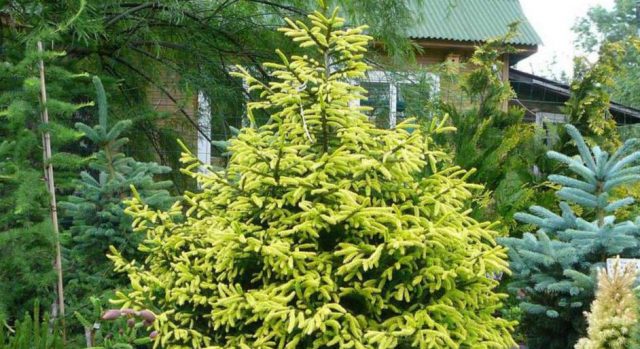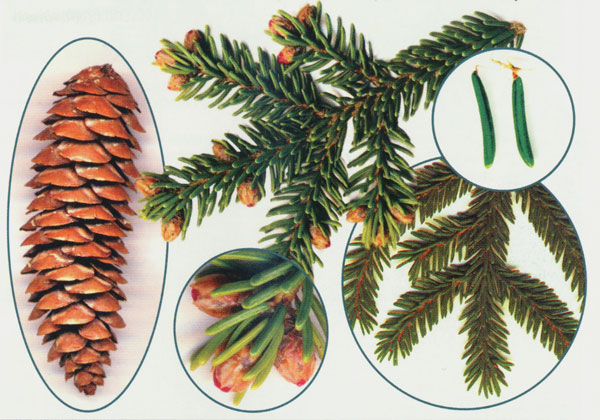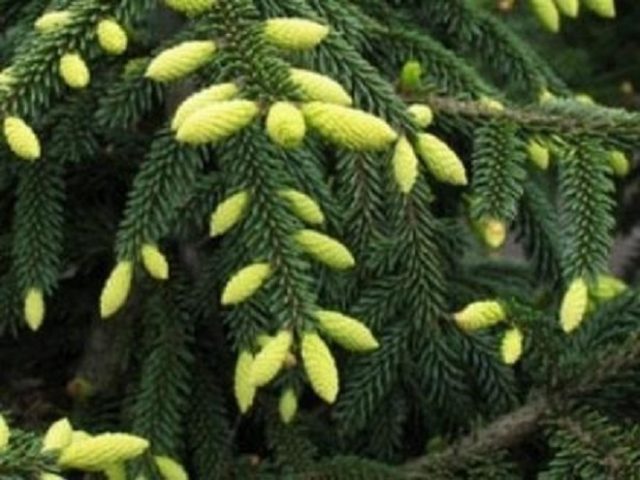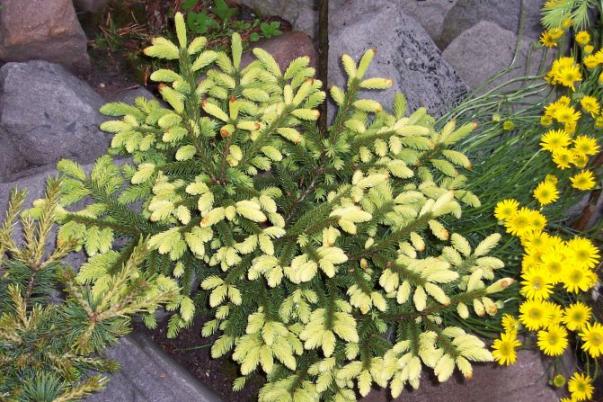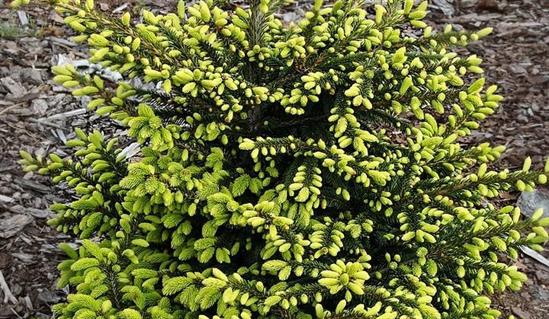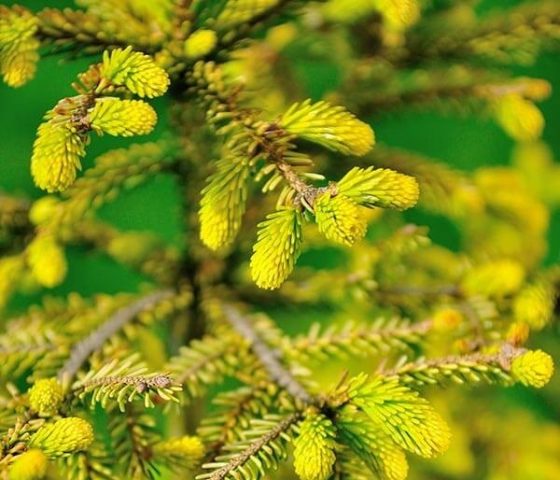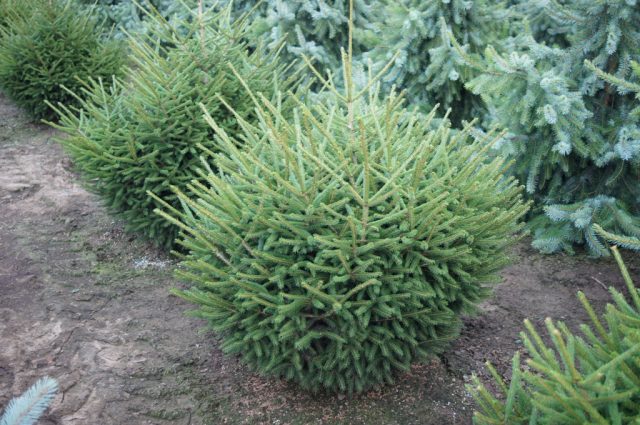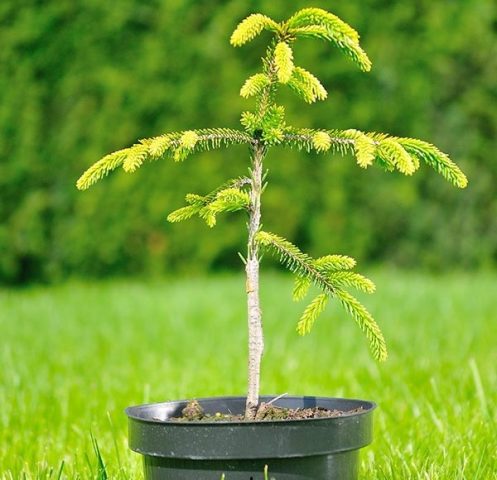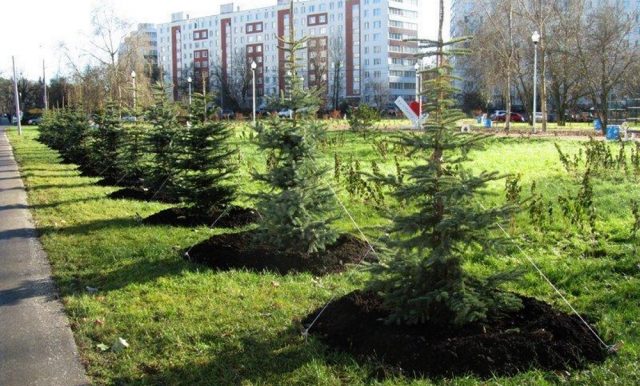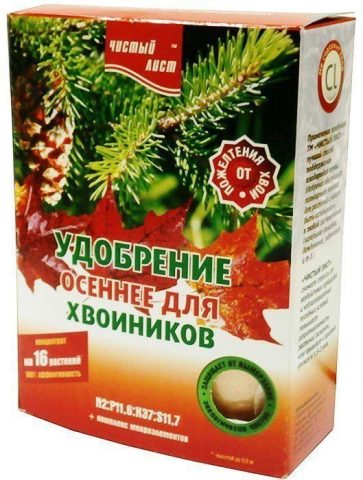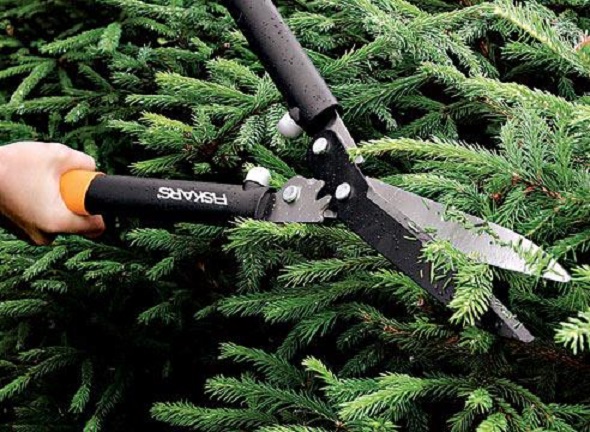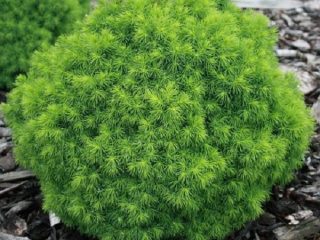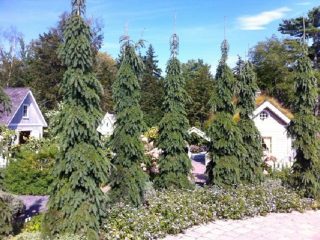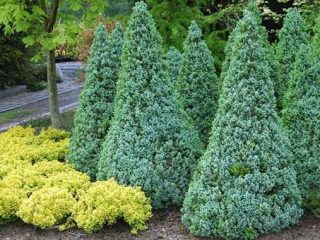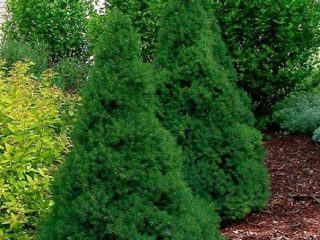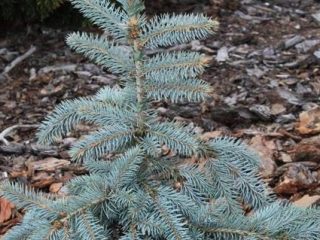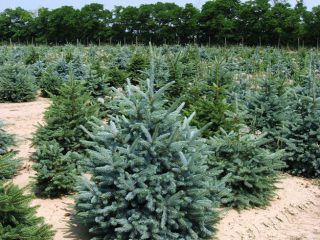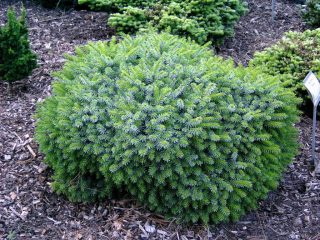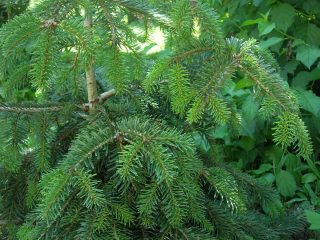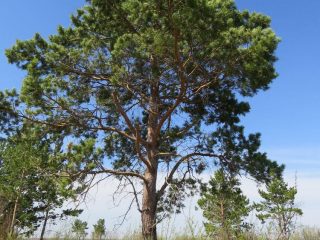Content
Eastern spruce (Picea orientalis) is one of 40, and according to some sources, 50 species belonging to the genus Spruce of the Pine family. This is a typical mountain plant, whose habitat is at an altitude of 1000-2500 m above sea level. The range of Eastern Spruce is the Caucasus, Türkiye, Asia Minor. Although this species is heat-loving, the crop grows well in the Middle Zone and some areas of the North-West, which belong to the 4th frost resistance zone.
Description of eastern spruce
Eastern spruce is an evergreen coniferous tree with a conical crown, sometimes called Caucasian spruce due to its wide distribution in the region. This species grows very slowly, especially at a young age (7-10 years), but over time it reaches a height of up to 65 m, and a trunk diameter of 2 m.
Oriental spruce grown from seeds at the 3-4th year of life forms a whorl on the crown, consisting of several buds directed to the sides and one apical one.At the beginning of the next season, side branches and a single vertical shoot with a new ring of buds grow from them.
The bark of the eastern spruce is light gray in color, smooth when young, but with age it cracks and peels off in plates. The needles, like those of other species, are tetrahedral, but much shorter and noticeably flattened. Its length is 4-8 mm, the color of the annual growth is golden, in subsequent seasons the color changes to dark green. The shoots of eastern spruce are densely covered with needles, which live 5-7 years in natural conditions, 3-4 in cultivation.
Female cones are first red, then chestnut or brown, up to 8 cm long, about 2 cm wide, resinous, spindle-shaped. They are located at the ends of branches in groups. The scales are almost round, shiny, the seeds are black, up to 4 mm, the wing size is twice as large. The male cones of eastern spruce are yellowish, located within the crown, bloom in late spring or early summer and release a lot of pollen. It scatters over a long distance, turning everything yellow.
The cones remain on the tree for quite a long time. At first they are green and pea-sized; in the second season they are fertilized and mature, reaching their maximum size. At the beginning of the third year, the cones open their scales and fall from the tree. Ripening time in the mountains is October-November, on the plains – August-September.
The lifespan of Eastern Spruce is 400-500 years.
Varieties
Eastern spruce is sensitive to severe frosts; most cultivars are grown in zones 4-7. The species plant shows low resistance to urban conditions. Therefore, selection is aimed not only at breeding low-growing varieties with an original crown shape, but also at increasing tolerance to anthropogenic factors.
Eastern spruce Aurea
This is a slow-growing variety of eastern spruce with a loose crown of irregular conical shape. In a year, the tree grows 15 cm in height and adds 5 cm to its width. The maximum size of spruce is 12, sometimes 15 m, crown diameter is up to 5.5 m. By the age of 30, the height of the plant is from 6 to 8 m.
When blooming, the needles are golden in color, turn green in summer, and become dark green in winter. The skeletal branches of the spruce are raised upward, the shoots extending from them are drooping.
This is a fairly unpretentious variety that can withstand urban conditions well and can grow in the sun and partial shade. But the winter hardiness of Aurea spruce is low (zone 5); in severe winters the needles darken.
The variety tolerates pruning well and can be used to create hedges. Recommended for medium to large sized areas.
Eastern spruce Aureospicata
A variety of German selection. The maximum size of a spruce is a height of 12 m with a width of 5 m. By the age of 10 it reaches 2.5 and 1.5 m, respectively, at 30 years it grows to 6-8 m. The eastern spruce Aureospicata differs from other varieties in the late opening of the buds - golden young shoots appear in June. Over time, the needles become dark green.
The crown of the spruce is dense, narrow pyramidal, the lateral branches are asymmetrical, with drooping shoots. Annual growth is no more than 20 cm. Young cones are purple, mature ones are brown, narrow, beautiful, up to 10 cm long.
The variety tolerates shearing well at a young age and is grown in a frost resistance zone of at least 5.
Eastern spruce Golden Start
This is a dwarf variety of eastern spruce, growing very slowly, reaching a height of 1.5-3 m with age with a width of 1.5 m. Its crown shape is wide-conical. The branches are widely spread and arranged horizontally. The height of a young spruce tree is usually the same as the diameter of the crown, the old one stretches out, the tips of the shoots droop.
The new year's growth is golden and gradually darkens over the course of the season, turning dark green by winter. The needles are short, hard, cones up to 8 cm long are first purple, then chestnut.
Spruce Golden Start is light-loving, but tolerates shade well. With a lack of sunlight, the golden color of young needles appears weaker or is completely absent. The frost resistance zone in which the variety can grow without shelter is not lower than 5.
Golden Start tolerates cutting well and is recommended for patios, rocky or oriental-style gardens. This spruce will be appropriate in small areas.
Eastern spruce Summergold
This variety differs from others in its symmetrical crown. By the age of 10, the spruce reaches 2 m, the old tree is never higher than 8 m. Young growth is golden, by the end of the warm season the needles gradually become dark green.
Spruce grows well in sun and slight shade. Recommended for medium and large areas.
Eastern Skylands spruce
This is one of the most popular varieties of eastern spruce in landscape design.It was bred in 1952 on farms in New Jersey. Spruce with short needles, which are at first bright yellow, then become golden, and only towards the end of the season acquires a dark green color. The crown is pyramidal; in an adult plant it narrows and elongates.
Landscape designers often play with the contrast of light yellow young needles and dark green old ones.
Eastern spruce Nigra Compacta
Perhaps this variety of eastern spruce is the most compact, as reflected in the name. At the age of 10 years, the tree may not reach a height of 1 m. The needles are shorter than those of other varieties, young ones are golden, and traditionally darken and become green with age.
Nigra Compacta winters well without shelter in frost hardiness zone 4. To create a more interesting crown, landscape designers often cut off the top of the tree, which makes the spruce look like a pillow. If you maintain this shape, the plant will direct all its forces to the development of lateral branches. By stopping pruning, you can get a tree with several tops and such a dense crown that it will look not like a cone, but a large egg or ball. This is clearly visible in the photo of the eastern Nigra Compacta spruce.
Planting and caring for oriental spruce
At a young age, spruce is quite finicky; when the tree grows, there are much fewer worries with it. The eastern one suffers the most due to dry air and gas pollution - these factors affect the lifespan of needles, and therefore the decorative value of the crop.
Preparing seedlings and planting area
Gardeners want to grow a beautiful oriental spruce, which will not only decorate the site, but will also purify the air and saturate it with phytoncides. To do this, they must carefully select a site and seedling.
Selection of seedlings
Eastern spruce seedlings are best purchased from nurseries, where they will be dug up in the presence of the future owner, or grown in containers. This requirement is due to the fact that all conifers die slowly, their needles remain green for a long time.
For example, spruce and pine trees intended for sale on New Year's Eve are harvested without permission in October or early November, and sometimes even in September. Then environmental and other regulatory authorities have not yet begun to conduct raids aimed at saving forests from illegal logging. Spruce and pine trees are stored in dark, damp hangars, and the needles remain green all this time. If, when buying a New Year's tree, the tips of the spines are yellow or brown - this is a clear sign, then the plant was cut down several months ago.
But what can we say about the period of digging up the spruce? A tree taken out of the ground with an open root system, if stored in a damp place, will retain its attractive appearance for a long time. After planting, the spruce may die, or it does not take root well, loses most of its needles, and subsequently gets constantly sick. It is difficult to make a claim to a trading organization - usually the complete death of the conifer, accompanied by drying out of the branches and complete shedding of needles, occurs only in the next season.
For planting, you can choose an adult tree grown in a container, or dug up with an earthen ball tied with burlap, or a 3-4-year-old seedling with a crown that has begun to form. Previously, it makes no sense to buy spruce - it is just one branch, and it is impossible to get even an approximate idea of varietal compliance. All representatives of the species have short needles and yellow or golden young growth.
You need to know all this when buying spruce, since even young varietal trees are not cheap, and mature trees can hurt the pockets of even wealthy people.
Site selection and preparation
Young eastern spruce should be protected from direct midday sunlight for at least the first few years of its life. Subsequently, the tree becomes light-loving, and even loses the golden color of the current year’s growth in the shade. Lack of sun does not affect the health of eastern spruce, but only reduces its decorative value. The tree's illumination should not be less than 6 hours a day, although the species is considered one of the most shade-tolerant.
Groundwater should not come closer than 1.5 m to the ground surface. As a last resort, make a drainage layer of broken red brick or expanded clay of at least 20 cm.
The soil for planting should be well permeable to water and air. Spruce does not even tolerate trampling of the soil. Moderately fertile, slightly acidic loams and sandy loams are suitable. High-moor (red) peat should be added to alkaline soils.
Landing rules
It is better to plant eastern spruce in the fall, in all regions. In the south, it is generally recommended to place it on the site after the first frost, and throughout the winter. Only in zone 4 is it better to postpone planting spruce until spring (although not necessarily).
The planting hole is dug in advance and allowed to settle for at least 2 weeks.Its diameter should be about a meter, depth - at least 60 cm. On dense soils or where water comes close to the surface, be sure to make a drainage layer of at least 20 cm.
To plant oriental spruce correctly, you need to prepare a special mixture. It consists of turf soil, sand and clay. Where the soil is alkaline, neutral, or contains a lot of salts, acidic (high-moor) peat is immediately added. A special fertilizer for coniferous plants is poured into each hole according to the instructions, in extreme cases - 100-150 g of nitroammophoska.
The pit is filled 2/3 with the prepared mixture, watered generously, and allowed to settle. Before planting, the eastern spruce root should not dry out. It depends on how quickly the tree takes root and what its health will be in the future. If the root is sewn into burlap, there is no need to remove it; the container (when the conifer was growing in it) is carefully removed just before planting.
The operation is carried out in the following sequence:
- A part of the soil is taken out of the hole so that the root collar of the spruce is at ground level.
- The seedling is placed in the center and carefully covered with the prepared nutrient mixture, constantly compacting it.
- Check and correct the position of the root collar.
- Water the eastern spruce abundantly, spending at least 2 buckets of water per planting hole.
- The tree trunk circle is mulched with acidic (red peat). The thickness of the layer should be no less than 5 cm.
Watering and fertilizing
Eastern spruce does not tolerate dry soil.Young trees are especially demanding when it comes to watering. The soil around them is regularly moistened not only immediately after planting, but also for several years, pouring 10-12 liters of liquid under each spruce in dry weather weekly.
After 10 years, the tree becomes, on the one hand, less sensitive to lack of water, and on the other hand, it begins to grow faster. This requires moisture. So eastern spruce always needs regular watering.
Dry air can also damage the tree. It’s good if there is a fog-forming installation on the site. If not, during hot, dry weather, your eastern spruce should be hosed down at least once a week. It’s only better to do this after 5-6 pm, if a sharp drop in temperature is not expected at night. If water gets on the branches in the morning, it can act like a lens and cause pine needles to burn. If the spruce is doused late in the evening, the tree will not be able to dry for a long time, and there is a danger of developing fungal infections.
If the planting hole has been well filled with fertilizers, there is no need to feed the tree for the first 2-3 years; then they should be applied at the root and through the needles several times a season. The need for intensive fertilizing is due to the fact that eastern spruce does not tolerate urban conditions well. To maintain the crown and root system, it needs nutrients and water. Without the addition of macro and microelements, the tree overwinters poorly, quickly loses needles and absorbs moisture worse.
It is better to use fertilizers for coniferous plants, and in accordance with the season: there are special fertilizers for spring and early summer that contain large amounts of nitrogen. At the end of the warm season and in the fall, spruce needs phosphorus and potassium.Special fertilizers for each group of plants contain a balanced complex of substances necessary for the crop in a given period.
Nowadays it is no longer necessary to buy expensive Western brands; domestic manufacturers have released inexpensive specialized supplements to the market. They must be used in accordance with the instructions. If the package indicates the dosage per 1 sq. m, it must be equated to 1 linear meter of tree growth.
For eastern spruce, which is poorly adapted to urban conditions, foliar feeding is of great importance, since the microelements necessary for the plant are better absorbed through the needles. It is better to use a chelate complex to which magnesium sulfate is added, and alternately epin or zircon.
Mulching and loosening
The root system of young eastern spruce first grows deeper. Then the tap root dies, but many horizontal shoots appear. The sucking roots are located close to the surface of the soil; they should not be disturbed unless absolutely necessary.
The soil should be loosened shallowly, no more than 5-7 cm, and only in the first years after planting. In the future, they are replaced by mulching the soil with acidic peat. You can use fallen pine needles as bedding, but they are often infected with pest larvae, fungal spores and pathogens of other diseases. It is almost impossible to completely disinfect it at home, as well as to guarantee that the needles collected somewhere are healthy, even though they seem clean.
In garden centers you can buy already processed bark of coniferous trees of different fractions.It perfectly covers the soil, conserves moisture and slightly acidifies the soil. Painted bark may look beautiful, but during watering and rain it clogs and clogs the ground.
Trimming
Eastern spruce tolerates pruning well at a young age. After 10 years, radical correction of the crown unless absolutely necessary is not recommended - you should maintain the shape that was given to the tree earlier, or leave it alone.
Proper pruning of conifers is akin to art. Caring for a spruce is much easier than tidying up other evergreen trees - the crown of the crop is already beautiful. To create a hedge, it is better to call a specialist. He will conduct an initial haircut and give recommendations on how to maintain shape.
Basic rules for pruning eastern spruce:
- the first haircut cannot be carried out in the year of planting;
- the procedure is carried out in early spring, before the buds open;
- even with radical pruning, more than 30% of the green mass of spruce cannot be removed;
- the instrument should be used sharp and sterile;
- bare branches cannot be left - they will dry out anyway;
- the cut should be made above the kidney, at an angle of 45°, retreating by 2 mm;
- if the branch grows upward, the cut is made above the downward-pointing bud, and vice versa;
- All dry and broken shoots must be removed;
- the old branch is cut with a saw, holding it so that it does not collapse, damaging the bark;
- wound surfaces with a diameter greater than 0.5 cm are treated with garden varnish or covered with special paint.
Preparing for winter
Residents of the North-West, Urals and Siberia, when purchasing eastern spruce, should ask what frost resistance zone the variety is intended for cultivation in. The species tree overwinters in the fourth. If the plant is located in its “own” zone, it needs to be covered only in the first year or two after planting. To do this, it is enough to throw spruce branches on the seedling or tie it with white agrofibre or lutrasteel. In spring, you should remember to remove the cover before the buds open.
In the future, you can limit yourself to mulching the soil with acidic peat. There is no need to remove it from the site at the beginning of the season; you just need to embed it shallowly into the soil.
Reproduction
Oriental spruce is propagated by seeds, which have good germination. But at the same time, the tree does not inherit varietal characteristics. Garden forms are often propagated by cuttings, rarely by grafting.
Before sowing in cold greenhouses, eastern spruce seeds must undergo stratification for 2-3 months - this significantly increases germination. Without treatment at low temperatures, planting material is soaked in settled water for a day. Seeds germinate in the year of planting. For the first 3-4 years, eastern spruce does not form whorls from which lateral branches grow.
The tree can be propagated by cuttings throughout the season, but spring ones take root best - within 4-5 months. Autumn ones take twice as long to establish. Cuttings are taken from the upper or middle part of the tree crown - they should have yellowish bark, 15-20 cm. The shoots that take root best are not cut, but torn off together with the heel (a piece of bark from an older branch). For better rooting, the wound surface is treated with a growth stimulator.
Oriental spruce can also be propagated by grafting, but this must be done by specialists.
Diseases and pests
Reviews of eastern spruce show that when planted in the right place, with a complete replacement of the soil, a carefully maintained tree gets sick and is rarely affected by pests.
Most diseases of eastern spruce can be avoided by carrying out preventive treatments with copper-containing preparations at the beginning and end of the season. The most common of them:
- snow shutte;
- fusarium;
- rot of the trunk and root system;
- Schutte;
- necrosis of the cortex;
- ulcerative cancer;
- rust of pine needles and cones;
- spruce spinner.
Among the pests of eastern spruce the following should be highlighted:
- red and yellow gall aphids;
- nun silkworm butterfly caterpillars;
- spruce budworm;
- spruce-fir Hermes;
- spider mite;
- common spruce sawyer.
Diseases are fought with fungicides, pests are destroyed with insecticides and acaricides. The sooner treatment is started, the more successful it will be. Once a week, coniferous trees should be carefully inspected with a magnifying glass.
Conclusion
Eastern spruce is one of the most beautiful coniferous crops. The species tree grows tall and does not tolerate urban conditions. The varieties are better suited for growing in garden plots. They remain small for a long time, and for a small spruce it is easy to build a shelter that can protect it even in cool or cold climates.
